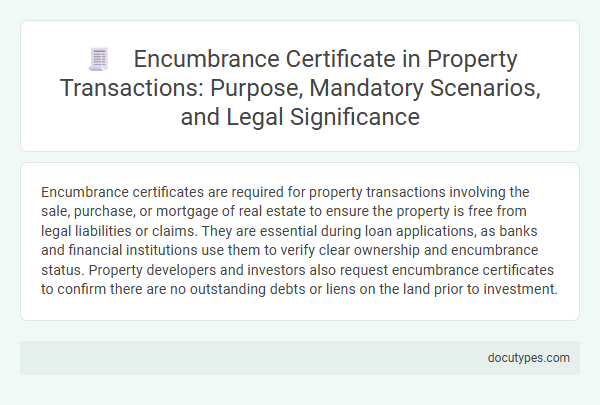Encumbrance certificates are required for property transactions involving the sale, purchase, or mortgage of real estate to ensure the property is free from legal liabilities or claims. They are essential during loan applications, as banks and financial institutions use them to verify clear ownership and encumbrance status. Property developers and investors also request encumbrance certificates to confirm there are no outstanding debts or liens on the land prior to investment.
Introduction to Encumbrance Certificate in Property Transactions
An Encumbrance Certificate (EC) is a crucial document in property transactions that verifies a property is free from legal dues or liens. You need this certificate to ensure a clear title before buying or selling property.
- Property Sale and Purchase - An Encumbrance Certificate confirms the property has no outstanding mortgages or legal liabilities.
- Bank Loan Approval - Banks require an EC to verify the property's clear title before approving home loans.
- Property Title Verification - The EC provides a record of all transactions related to the property, proving its marketability and ownership status.
Understanding the Purpose of an Encumbrance Certificate
An Encumbrance Certificate (EC) is essential in property transactions to confirm that the property is free from any legal or monetary liabilities. Transactions such as property sales, purchases, mortgage registrations, and loan approvals require an EC to verify that no encumbrances like unpaid taxes, liens, or disputes exist. Understanding the purpose of an Encumbrance Certificate helps ensure the property's clear status, protecting buyers and financial institutions from potential legal complications.
Key Components Detailed in an Encumbrance Certificate
An Encumbrance Certificate (EC) is essential for property transactions to ensure the title is free from monetary and legal liabilities. Various property-related transactions require an EC to verify clear ownership and encumbrance-free status.
- Sale or Purchase of Property - An EC confirms that the property is free from any legal or financial burdens before transfer of ownership.
- Property Registration - Registering property with local authorities mandates an EC to establish the property's legal standing.
- Loan or Mortgage Application - Lenders require an EC as proof that the property does not have prior encumbrances affecting the loan security.
Key components detailed in an Encumbrance Certificate include a chronological list of transactions, names of parties involved, and the description of the property. Verification of encumbrances such as mortgages, liens, or legal disputes is also documented for comprehensive clarity.
- Transaction History - The EC lists all recorded transactions affecting the property over a specific period.
- Parties Involved - It identifies the buyers, sellers, and other relevant entities related to each transaction.
- Property Description - The EC specifies the property's location, boundaries, and unique identification details.
Legal Significance of the Encumbrance Certificate
An Encumbrance Certificate (EC) is crucial for verifying that a property is free from legal liabilities such as mortgages, liens, or unpaid loans. It is required in property sale, purchase, and loan transactions to ensure the title is clear and to protect the interests of buyers and financial institutions. The legal significance of the EC lies in its role as an official document confirming the property's unencumbered status, preventing future disputes or ownership challenges.
Scenarios Where the Encumbrance Certificate is Mandatory
An Encumbrance Certificate (EC) is essential during property transactions to verify that the property is free from any legal or monetary liabilities. It confirms the absence of loans, mortgages, or unpaid dues attached to the property.
Scenarios requiring an EC include buying or selling property, where clear title is crucial for transferring ownership. It is mandatory when applying for a home loan or during property partition and inheritance to ensure the property has no encumbrances.
Step-by-Step Procedure to Obtain an Encumbrance Certificate
| Types of Transactions Requiring an Encumbrance Certificate & Step-by-Step Procedure to Obtain It | |
|---|---|
Types of Transactions Requiring an Encumbrance Certificate
|
Step-by-Step Procedure to Obtain an Encumbrance Certificate
|
How to Verify and Interpret Encumbrance Certificate Entries
Encumbrance Certificates (EC) are essential for property transactions like sale, mortgage, and inheritance to ensure the property is free from legal dues. You must obtain an EC to confirm the property's clear title before proceeding with these transactions.
To verify an EC, check the entries for all past transactions and statutory liabilities recorded over the years. Interpret the data by confirming no loans, mortgages, or legal claims exist on the property, as these encumbrances affect ownership rights.
Common Issues and Red Flags in Encumbrance Certificates
Encumbrance certificates are essential for property transactions such as property purchases, sales, or mortgage clearance. They confirm the property is free from legal liabilities and financial burdens.
Common issues in encumbrance certificates include incomplete transaction history and discrepancies in property details, which may cause legal complications. Red flags often involve unregistered mortgages or liens that are not mentioned. Verifying the certificate thoroughly protects your property investment from hidden claims.
Differences Between Encumbrance Certificate and Other Property Documents
What types of transactions require an Encumbrance Certificate? Transactions involving the sale or purchase of property commonly require this certificate to verify the property's clear title. You need an Encumbrance Certificate to ensure there are no legal or monetary liabilities attached to the property.
How does an Encumbrance Certificate differ from other property documents? Unlike sale deeds or title deeds, the Encumbrance Certificate specifically records any charges or liabilities on the property. Other documents primarily demonstrate ownership, while the Encumbrance Certificate confirms the property is free from encumbrances.
What Types of Transactions Require an Encumbrance Certificate? Infographic

